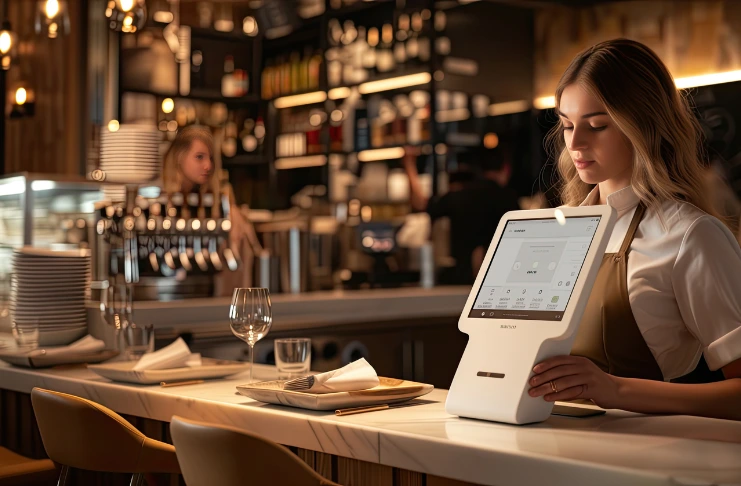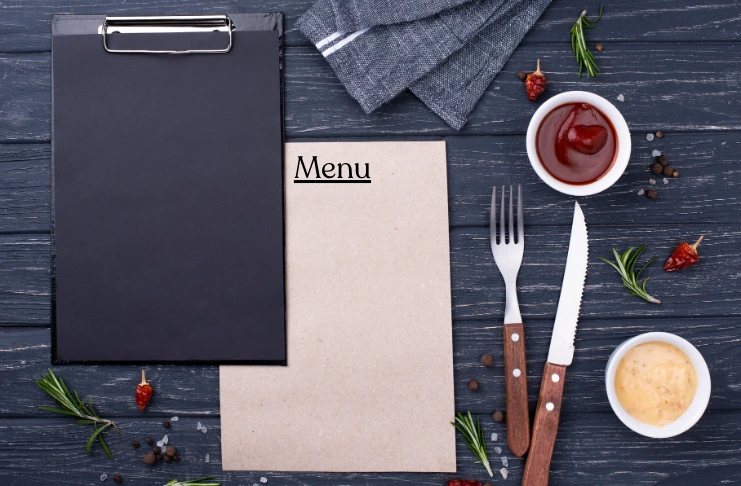In the bustling world of restaurants, where margins are tight and competition fierce, your menu isn’t just a list of profitable items—it’s your most powerful marketing tool. Restaurant menu engineering combines psychology, design, and economics to transform ordinary offerings into profit powerhouses.
Think of your menu as a chess board. Each item is a strategic piece, carefully positioned to capture your customers’ attention and boost your bottom line. The beauty of menu engineering lies in its blend of creativity and calculation.
When diners scan your menu, their eyes follow predictable patterns. The top right corner? Prime real estate. Those colorful boxes highlighting certain dishes? Not just decorative—they’re steering customers toward your high-profit items. Even the absence of dollar signs is a calculated choice, softening price resistance.
Behind every successful menu is a dance of data—food costs, contribution margins, and popularity rankings coming together in a profit-maximizing symphony. Menu engineering analyzes these metrics, helping you identify your stars (high-profit, high-popularity items) and your puzzles (high-profit but underperforming dishes that need better positioning).
Remember that Italian restaurant where you instinctively ordered the chef’s signature pasta? That wasn’t a coincidence—it was restaurant menu engineering at work. The dish was likely placed in the “sweet spot,” described with mouthwatering language, and possibly even highlighted with a subtle box or illustration.
Your menu tells your restaurant’s story, but with menu engineering, it also writes your path to profitability. The most successful restaurateurs understand this science, constantly testing, measuring, and refining their menus to achieve the perfect balance of customer satisfaction and business success.
The Psychology Behind Menu Engineering

Restaurant menu engineering isn’t just about crunching numbers—it’s a delicate fusion of data-driven strategy and consumer psychology. Through menu analysis, this sophisticated approach transforms your menu from a simple list of offerings into a powerful tool that subtly shapes how diners think, feel, and ultimately choose.
At its core, menu engineering analyzes the twin pillars of profitability and popularity, then applies psychological principles to guide customer behavior toward high-margin items. Your menu becomes a silent salesperson, using visual cues, strategic layout, clever pricing techniques, and evocative language to influence decisions without customers ever feeling manipulated.
The ‘Golden Triangle’ of menu engineering—that prime area where the eye naturally lands first—becomes your “My Precious!”. Here, you’ll showcase your stars: dishes with high margins and strong appeal. Meanwhile, emotion-evoking descriptors like “grandmother’s secret recipe” or “sustainably harvested” create connections and justify premium pricing, while the strategic absence of dollar signs removes psychological barriers to spending.
Effective restaurant menu engineering creates a win-win scenario: your bottom line improves while customers enjoy a simplified decision-making process and enhanced perception of value. The magic happens when diners leave feeling they’ve made independent choices, unaware that every element—from font size to color psychology—was carefully engineered to guide their journey through your menu.
When your menu engineering strategy aligns with your brand story and customer expectations, you’ve mastered not just the science of profitability, but the art of subtle persuasion.
Importance of Menu Engineering in Restaurants

In the competitive culinary landscape, menu engineering stands as a game-changer for restaurants seeking both financial success and customer loyalty. This powerful approach transforms your menu from a simple list into a strategic asset that silently shapes dining experiences and drives profitability.
When masterfully implemented, menu engineering creates a perfect harmony between business objectives and menu performance, as well as guest satisfaction. High-margin signature dishes become spotlighted through strategic placement and visual emphasis, naturally drawing the diner’s eye and increasing their selection rate by up to 30%. Meanwhile, this deliberate design reduces decision fatigue, helping guests confidently navigate choices rather than being overwhelmed.
Beyond the front-of-house benefits, a thoughtfully engineered menu orchestrates kitchen efficiency by promoting items that optimize inventory usage and preparation time. This strategic alignment between customer choices and operational strengths significantly reduces food waste and labor costs—turning potential losses into preserved profits.
The true brilliance of menu engineering lies in its invisibility to the guest. While they perceive only an appealing, easy-to-navigate menu that enhances their dining journey, you recognize the carefully calculated psychology and data analysis working silently behind each element—building your bottom line while simultaneously elevating the customer experience.
Key Components of Menu Engineering

To successfully engineer a menu, consider the following components:
1. Cost Analysis: Laying the Profitability Foundation
Before you can influence choices, you need to know which dishes are worth influencing customers toward. This starts with a solid understanding of food cost per item, which includes raw ingredients, labor, and waste.
But here’s the twist: just because something is cheap to make doesn’t mean it should be priced cheaply. Enter perceived value—a psychological principle where customers judge a dish’s worth not just by ingredients but by presentation, description, and context.
2. Sales Data Evaluation: Understand Customer Behavior
Analyzing which menu items sell the most provides insight into real-world customer preferences. It reveals unconscious patterns—what guests gravitate toward during different meal times, seasons, or price points.
However, beyond popularity, consider choice overload: when customers face too many options, they default to the familiar or highlighted choice. That’s where understanding sales data becomes crucial—it allows you to spotlight items people already lean toward, reducing their cognitive load and increasing satisfaction.
3. Menu Item Categorization: Strategic Classification Based on Performance
An essential element of effective restaurant menu engineering involves categorizing each menu item based on two key performance indicators: profitability and popularity. This analysis allows operators to make informed decisions that balance customer satisfaction with financial optimization. The following four-category matrix forms the foundation of this approach:
Stars – High Profitability, High Popularity
These are the standout performers on your menu. They are both financially lucrative and consistently favored by guests. These items should be prominently featured and remain unchanged unless minor enhancements in presentation or description can further increase appeal. Strategically positioning them in high-visibility areas of the menu—such as the “Golden Triangle”—maximizes their impact.
Plowhorses – Low Profitability, High Popularity
Plowhorses are popular among guests but offer limited contribution to profit margins. Rather than removing them, consider refining portion sizes, adjusting ingredient costs, or implementing subtle price increases. Additionally, explore opportunities for strategic upselling—such as offering premium add-ons or pairing with high-margin sides—to improve overall profitability.
Puzzles – High Profitability, Low Popularity
These items yield strong margins but receive limited customer attention. The goal is to increase their appeal without compromising cost-efficiency. Strategies may include renaming the item for better customer resonance, enhancing its description, repositioning it on the menu for greater visibility, or bundling it with more popular dishes. Often, low popularity can be attributed to inadequate menu placement or uninspired language rather than the dish itself.
Dogs – Low Profitability, Low Popularity
Items in this category underperform in both revenue generation and guest demand. While they may serve niche purposes (e.g., dietary needs or menu diversity), they should be reviewed critically to ensure a profitable menu. If they do not align with strategic goals or brand identity, phasing them out can improve overall menu clarity and operational efficiency.
This categorization framework ensures that every dish on your menu serves a purpose—either by driving profit, satisfying demand, or supporting brand positioning. Applying this analysis regularly enables data-driven adjustments that align culinary offerings with business performance.
4. Menu Design & Layout: Guide the Gaze, Influence the Choice
Here’s where menu psychology really shines. Research shows that customers spend less than 2 minutes reading a menu—often just 109 seconds on average. That means first impressions matter more than anything.
Key psychological tactics include:
- The Golden Triangle: Eye tracking studies show that customers’ eyes first move to the center of a menu, then top right, then top left. Place high-margin items in these zones.
- Visual Anchoring: Use boxes, icons, and whitespace to guide attention. Too many highlighted items create confusion; spotlight only the most profitable.
- Descriptive Language: Using vivid, sensory-rich adjectives boosts sales by 27% and also increases the likelihood that customers would purchase those items again on return visits, according to a Cornell study. Think “buttery, hand-rolled croissants” vs. just “croissants.”
- Price Psychology: Remove currency symbols ($), which trigger pain perception. Instead, present clean numbers (“18” instead of “$18.00”). Studies show this subtly increases spending.
- Decoy Pricing: Place a slightly more expensive item next to your desired “sell” to make it seem like better value. This plays into comparison bias.
Effective menu designing is not just about aesthetics– it’s a calculated blend of psychology, strategy, and user experience. Every visual cue, word choice and layout decision plays a subtle yet powerful role in guiding customer behaviour. By leveraging proven psychological techniques– like Golden Triangle, value framing, descriptive language– restaurants can shape perceptions, ease decisions, and drive higher-margin choices.
When thoughtfully applied, these design elements not only improve profitability, but also elevate overall dining experience. A well-engineered menu doesn’t just list dishes– it tells a story, evokes emotions.
Steps to Implement Menu Engineering

Implementing menu engineering in your restaurant is not a one-time fix—it’s a cyclical and data-driven process that integrates cost control, behavioral insights, and strategic design. Whether you’re managing a small café or a large multi-location restaurant, these steps can help optimize your menu for both guest satisfaction and profitability.
1. Gather and Analyze Data
The first step in menu engineering is building a robust foundation of data. This includes:
- Food cost per item (ingredient cost, prep time, portion sizes)
- Sales volume (number of times each item is ordered)
- Gross profit per dish (menu price minus food cost)
- Customer feedback (verbal, survey-based, or via reviews)
This data can be extracted from your POS system, inventory tracking software, or financial reports.
2. Categorize Menu Items
Using the performance data, classify each menu item into the Menu Engineering Matrix:
- Stars (high profit, high popularity)
- Plowhorses (low profit, high popularity)
- Puzzles (high profit, low popularity)
- Dogs (low profit, low popularity)
This classification enables you to identify where to focus your attention and investment.
3. Redesign the Menu
With item categorization complete, it’s time to redesign your menu strategically:
- Highlight Stars in prime visual zones (e.g., center of the page or top-right quadrant).
- Enhance Puzzles through persuasive descriptions, placement, or visual callouts.
- Reevaluate Plowhorses by experimenting with portion sizes and pricing strategies or bundling them with high-margin items.
- Remove or replace Dogs unless they serve a functional or niche purpose (e.g., dietary accommodations).
4. Test, Monitor, and Revise
After the menu redesign is launched, closely monitor:
- Sales performance of reclassified and repositioned items
- Customer behavior (e.g., time spent reading menus, hesitation, feedback)
- Profit margins and food cost ratios
- Operational impact (e.g., preparation time, inventory turnover)
Menu engineering is not static. Seasonal shifts, ingredient costs, and evolving customer preferences require regular reviews—ideally every quarter or biannually.
Performance Review Checklist
Make a checklist to review and make changes accordingly:
- Did Stars maintain or increase their performance?
- Did Puzzle sales improve with new descriptions or placement?
- Are Plowhorses more profitable post-adjustment?
- Are Dogs still relevant—or are they holding back performance?
Ongoing reviewing and testing ensure your menu remains effective over time.
Implementing menu engineering is a powerful strategy to balance culinary creativity with financial intelligence. When grounded in accurate data and enriched with behavioral insights, it becomes a dynamic tool to boost profit, enhance guest satisfaction, and streamline operations. By continually optimizing based on performance, you ensure your menu doesn’t just reflect your brand—it drives it forward.
Most Profitable Restaurant Menu Items

In restaurant menu engineering, profitability doesn’t just come from high-priced items—it comes from high-margin items that offer excellent value perception to customers while keeping food cost percentage low. The following categories consistently rank among the most profitable dishes across the food service industry:
1. Burgers
Burgers remain a cornerstone of profitability for many casual and quick-service restaurants. Their appeal lies in their versatility—simple ingredients like ground beef, buns, cheese, and condiments can be transformed into gourmet offerings with specialty toppings or artisanal buns, justifying premium pricing.
- Why it’s profitable: Low ingredient cost, minimal prep time, and high perceived value.
- Strategic edge: Menu innovation (e.g., “smash burgers,” plant-based options, or regional styles) can command even higher price points.
2. Pizzas
Pizzas offer exceptional profit margins due to their simplicity and scalability. Basic ingredients—dough, sauce, cheese, and toppings—are affordable, yet customers are willing to pay premium prices, especially for personalized or gourmet options.
- Why it’s profitable: Low cost per unit, mass prep potential, and highly shareable format.
- Strategic edge: Offering “build-your-own” or regional specialties (e.g., Neapolitan, Detroit-style) can attract diverse demographics.
3. Pasta Dishes
Pasta is one of the highest-margin menu categories, especially when combined with simple sauces like Alfredo, marinara, or garlic-butter blends. It’s filling, customizable, and beloved across demographics.
- Why it’s profitable: Pasta is inexpensive, easy to store, and quick to cook.
- Strategic edge: Upscale ingredients like truffle oil or seafood additions allow significant price markups.
4. Vegetarian & Plant-Based Dishes
Vegetarian meals often feature grains, legumes, seasonal vegetables, and tofu—all lower-cost alternatives to meat-based dishes. At the same time, they cater to a fast-growing segment of health-conscious, flexitarian, and vegan diners.
- Why it’s profitable: Lower cost of ingredients + high demand from ethical and health-conscious consumers.
- Strategic edge: Positioning vegetarian dishes as “chef-crafted” or “plant-forward” enhances their perceived value.
5. Soups and Stews
Soups and stews are an excellent vehicle for batch cooking and ingredient repurposing. They often use trimmed vegetables, bones, or lower-cost proteins while delivering high perceived value due to rich flavors and hearty portions.
- Why it’s profitable: It can be made in bulk, has a long shelf life, and has minimal waste.
- Strategic edge: Offering seasonal or locally inspired soups adds freshness and justifies premium pricing.
INDUSTRY INSIGHTS
| Hamburgers are among the top American dishes, with a popularity so high that an average American eats 3 hamburgers per week among U.S. adults, while approximately one in eight Americans consumes pizza on any given day. Italian food, which prominently features pasta dishes, is served at over 100,000 restaurants across the U.S., and soups constitute a significant 32% share among all restaurant menu items in the U.S., highlighting their widespread availability and popularity. These statistics point out the popularity of these items and how you, too, can add them to your menu to increase profitability. |
Identifying and promoting your most profitable restaurant menu items is essential for sustainable success. These dishes should not only be strategically priced but also highlighted through menu design, descriptive language, and visual cues that increase their perceived value.
By aligning customer psychology with cost-smart choices, your menu becomes a tool not just for showcasing your cuisine—but for driving meaningful profit margins every day.
Leveraging Technology in Menu Engineering

As the restaurant industry becomes increasingly data-driven, technology has emerged as a critical enabler of intelligent menu design. Gone are the days of relying solely on intuition or static spreadsheets. Today’s restaurateurs have access to powerful tools that analyze customer behavior, streamline operations, and maximize profitability with precision. Here’s how cutting-edge tech is transforming the menu engineering process:
1. Point-of-Sale (POS) Systems: Your Built-In Business Intelligence
Modern POS systems go far beyond processing transactions—they function as data hubs for understanding customer behavior and item performance.
Key Functions:
- Track real-time sales data by item, category, and time of day.
- Identify top-performing and low-performing menu items.
- Generate reports on gross profit, inventory turnover, and seasonal trends.
- Monitor customer ordering patterns and average ticket size.
By extracting item-level data from your POS system, you can quantitatively categorize menu items into Stars, Plowhorses, Puzzles, and Dogs—essential for effective menu engineering.
2. Menu Engineering Software: Precision Meets Automation
Dedicated menu engineering tools take data from POS systems and translate it into actionable insights. These platforms automate the analysis of sales volume, food cost, contribution margin, and item performance, and many also offer visual layout suggestions.
Popular Features:
- Automatic categorization of menu items using the menu engineering matrix
- Identification of profit leaks and underutilized pricing opportunities
- Visual dashboards for tracking item performance
- Integration with cost databases to monitor real-time margin changes
Integrate menu engineering tools as they save time and eliminate guesswork, allowing you to focus on strategic pricing, bundling, and design adjustments that improve margins.
3. Artificial Intelligence (AI): Predictive, Personalized, Profitable
AI is reshaping menu engineering by bringing predictive analytics and behavior modeling into the equation. It’s no longer just about analyzing what’s sold—it’s about anticipating what will sell, to whom, and when.
Key Applications:
- Dynamic pricing models based on demand, weather, or events
- Personalized menu suggestions for repeat customers based on past behavior
- Customer segmentation for tailoring menu formats (e.g., mobile vs. dine-in)
- Waste prediction based on inventory and historical consumption trends
AI can forecast which items are likely to underperform during certain shifts, helping you avoid waste and automatically rotate in more profitable alternatives.
Integrating technology into menu engineering allows restaurateurs to make decisions faster, smarter, and more profitably. From POS insights to AI-powered predictions, today’s tools give you the ability to fine-tune your offerings with surgical precision—transforming your menu from a static list into a dynamic profit engine.
Whether you’re running a single-location café or a multi-unit operation, embracing these technologies ensures your menu isn’t just built for today—it’s ready for tomorrow.
Challenges in Menu Engineering (And How to Overcome Them)

While restaurant menu engineering has the potential to significantly boost profitability, it isn’t without its pitfalls. Creating a profitable, data-driven menu is not just about placing items strategically—it’s about navigating complex, ever-evolving dynamics of operations, customer behavior, and market forces. Here’s a closer look at the most common challenges, along with solutions to overcome them
1. Data Accuracy
The Challenge
Menu engineering relies heavily on quantitative data—like food cost, sales volume, and profit margins. But if this data is outdated, misreported, or manually inputted with errors, the decisions based on it may do more harm than good.
Inaccurate data can result in poor categorization of menu items, mispriced dishes, or the removal of popular, high-margin options.
Solution
- Integrate smart POS systems with real-time reporting and built-in error checks.
- Use a recipe costing software to calculate precise per-dish margins.
- Establish a weekly review cadence for data accuracy—cross-checking sales, food costs, and customer feedback.
Automate as much data collection as possible and assign a team member to oversee regular audits to reduce human error.
2. Customer Preferences
The Challenge
A high-margin item isn’t profitable if no one orders it. At the same time, some customer favorites (like fries or basic pastas) may be low-margin but essential for keeping guests satisfied and loyal.
The risk lies in removing or deprioritizing “low-profit” items without understanding their strategic role in customer satisfaction or overall menu balance.
Solution
- Conduct menu mix analysis: Identify which low-margin items drive volume and create bundling opportunities.
- Use A/B menu testing to see how customers respond to replacements or repositioning.
- Survey customers regularly through email or table tents to understand taste shifts and expectations.
Sometimes, a popular “Plowhorse” is the comfort food anchor that builds trust—use it to sell a premium add-on or combo rather than eliminating it.
3. Market Trends
The Challenge
Food preferences change rapidly. What was trendy last year (e.g., keto, charcoal-infused foods) might be out of fashion today. Failing to align with consumer expectations and industry shifts can leave your menu feeling outdated or out of touch.
Restaurants that don’t evolve with the market risk losing relevance, especially with younger, trend-driven diners.
Solution
- Use trend monitoring tools to stay informed.
- Keep a flexible “rotating specials” section on your menu to test emerging trends without overhauling your entire offering.
- Follow competitor menus and customer reviews on platforms like Yelp, Instagram, and Uber Eats for real-time insights.
Assign one team member or manager as your “menu innovation lead” to track trends and propose quarterly updates.
4. Operational Constraints: Behind-the-Scenes Struggles
The Challenge
Even a brilliantly engineered menu can flop if it’s too complex for the kitchen or hard to execute consistently. Limited kitchen space, insufficient training, or supply chain inconsistencies can undermine new or restructured menu items.
If an item is profitable on paper but logistically burdensome, it could lead to delays, poor reviews, or staff burnout.
Solution
- Evaluate kitchen capabilities before adding any new items—do a feasibility check.
- Use batch-prepped sauces, components, or versatile ingredients across multiple dishes.
- Involve your BOH (Back of House) team early in the menu design process to ensure operational buy-in.
Instead of adding five new sauces, create one master base and offer variations (spicy, creamy, herb-infused) to keep prep manageable while boosting perceived variety.
5. Resistance to Change: Cultural and Staff Barriers
The Challenge
Changing the menu—even for the better—can spark resistance from your team or long-term customers who are emotionally attached to certain items. This inertia can make implementation slow or inconsistent.
When menu engineering isn’t communicated properly, it may be seen as a top-down decision that disregards input from floor staff or chefs.
Solution
- Host pre-launch tastings and staff workshops to explain the business rationale and get buy-in.
- Provide servers with upselling scripts and margin awareness so they can guide customers effectively.
- Soft-launch changes with limited-time offers (LTOs) to ease regulars into new options.
Frame changes not just as profit-driven but as a way to elevate the guest experience—your team will naturally align.
Menu engineering isn’t a one-time tweak—it’s an ongoing optimization loop. By proactively addressing these challenges with thoughtful strategies and the right tech tools, you can create a menu that not only looks great and drives profits but also resonates with your customers and empowers your team.
In short: Don’t let data gaps, trend shifts, or kitchen hurdles hold you back. With a systemized approach, every challenge becomes a competitive advantage.
Conclusion
As we’ve explored throughout this guide, restaurant menu engineering is far more than a passing industry trend—it’s an essential discipline for establishments determined to thrive in today’s competitive landscape. The strategic fusion of psychology, design, and financial analysis creates a powerful tool that works continuously to boost your bottom line.
The beauty of menu engineering lies in its adaptability. Whether you operate a cozy neighborhood bistro or an upscale dining destination, these principles can be tailored to complement your unique brand story and customer base. And remember, this isn’t a one-time project but an ongoing process of refinement as you analyze results, gather customer feedback, and respond to changing market conditions.
By embracing the science of menu engineering while honoring the art of your culinary vision, you create an experience that satisfies both your guests’ appetites and your financial goals. Your menu becomes not just a list of offerings but a strategic asset that silently works to highlight your stars, elevate your puzzles, and maximize every dining opportunity.
The journey to menu mastery begins with a single step—analyzing your current offerings and applying these proven techniques. The rewards—increased profits, streamlined operations, and enhanced guest satisfaction—await those willing to look beyond ingredients and see their menu through the lens of strategic possibility.
Ready to engineer your way to better profits? Your menu awaits its makeover!
Frequently Asked Questions
1. How to engineer a restaurant menu?
You can engineer your restaurant menu by analyzing item profitability and popularity, then optimizing placement, pricing, and designing accordingly.
2. What are the 4 categories of menu engineering?
4 categories of menu engineering are: Stars, Plowhorses, Puzzles, and Dogs—based on profitability and sales volume.
3. What are the 4 quadrants of menu engineering?
4 quadrants of menu engineering are: high profit & high popularity (Stars), high popularity & low profit (Plowhorses), high profit & low popularity (Puzzles), low profit & low popularity (Dogs).
4. What is the menu engineering approach?
A strategic method of evaluating and designing menus to maximize profitability and customer appeal.
5. What is the most profitable food in a restaurant?
Dishes with low food costs and high perceived value—like pasta, pizza, or soups are most profitable food in a restaurant.
6. What food item makes the most money?
The food item that makes the most money is pizza, which often leads due to low ingredient cost and high markup potential.
7. What food item has the highest profit margin?
Beverages (especially soft drinks and coffee) and appetizers typically have the highest margins.
8. Which food item business is most profitable?
Fast-casual and delivery-focused businesses like cloud kitchens or pizza outlets are highly profitable.
9. What does a menu engineer do?
A menu engineer analyzes sales and food cost data to optimize a restaurant’s menu for profit and performance.
10. What are the three elements of menu engineering?
Three elements of menu engineering are: profitability, popularity, and menu design/placement.
11. What is the golden triangle of menu engineering?
A visual strategy placing high-margin items where the eye naturally goes first—center, top right, and top left of the menu is called The Golden Triangle.
12. What are the reasons for menu engineering?
Menu engineering is implemented to increase revenue, reduce waste, improve customer satisfaction, and streamline operations.
13. How to do menu planning for restaurants?
To plan a menu for restaurants, consider target audience, pricing strategy, kitchen capacity, and ingredient costs while aligning with your brand identity.
14. What is the basic menu engineering?
Evaluating items based on cost and popularity, categorizing them, and optimizing menu layout and pricing for profit are basics of menu engineering.





